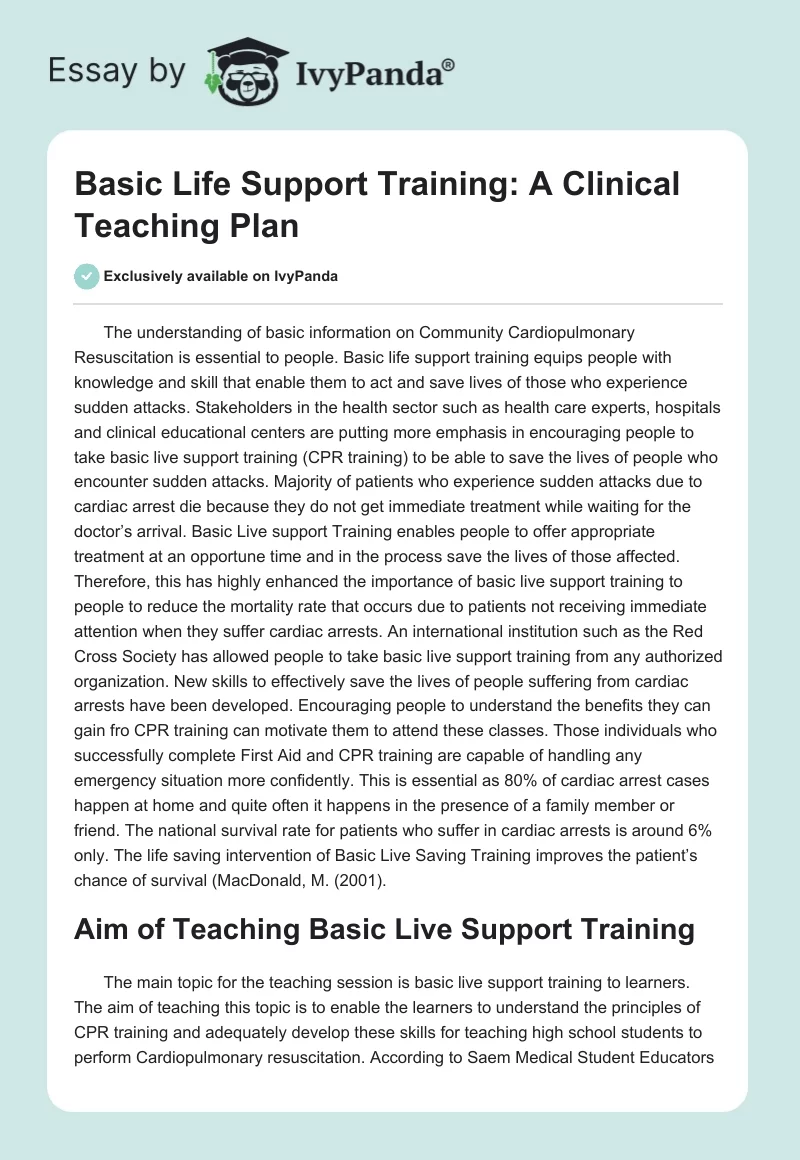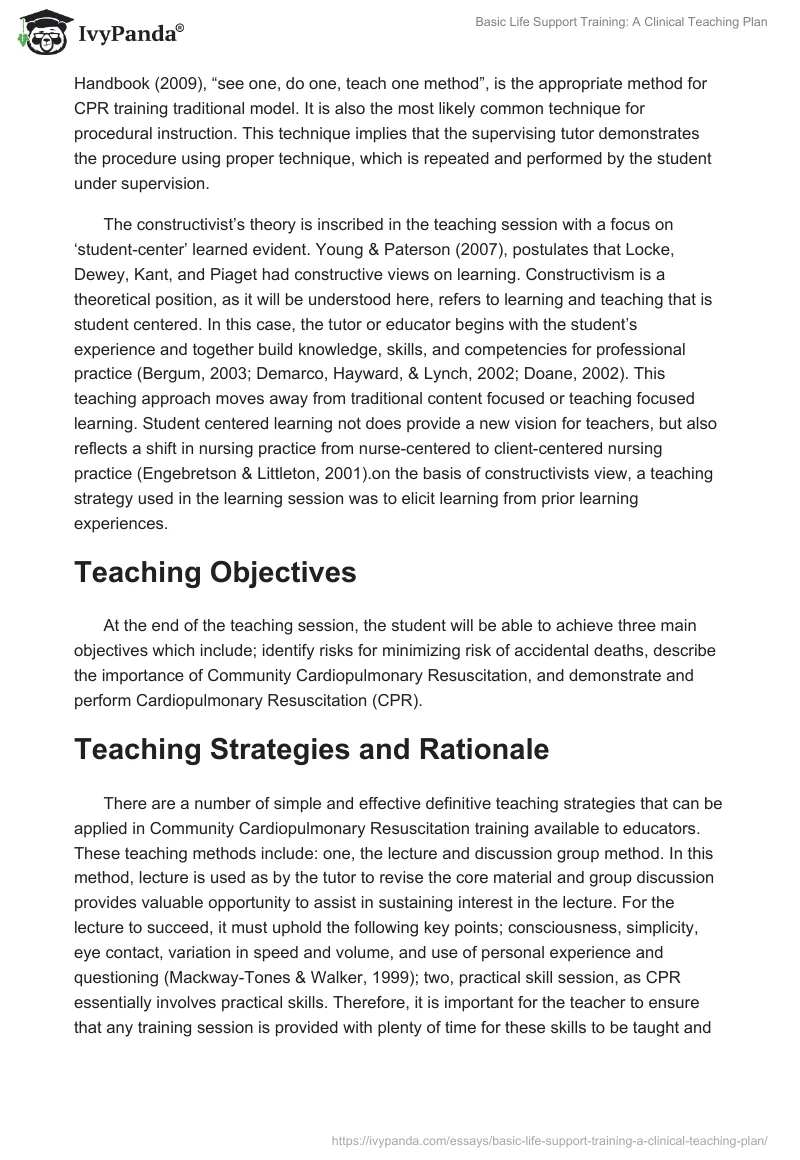The understanding of basic information on Community Cardiopulmonary Resuscitation is essential to people. Basic life support training equips people with knowledge and skill that enable them to act and save lives of those who experience sudden attacks. Stakeholders in the health sector such as health care experts, hospitals and clinical educational centers are putting more emphasis in encouraging people to take basic live support training (CPR training) to be able to save the lives of people who encounter sudden attacks. Majority of patients who experience sudden attacks due to cardiac arrest die because they do not get immediate treatment while waiting for the doctor’s arrival. Basic Live support Training enables people to offer appropriate treatment at an opportune time and in the process save the lives of those affected.
Therefore, this has highly enhanced the importance of basic live support training to people to reduce the mortality rate that occurs due to patients not receiving immediate attention when they suffer cardiac arrests. An international institution such as the Red Cross Society has allowed people to take basic live support training from any authorized organization. New skills to effectively save the lives of people suffering from cardiac arrests have been developed. Encouraging people to understand the benefits they can gain fro CPR training can motivate them to attend these classes. Those individuals who successfully complete First Aid and CPR training are capable of handling any emergency situation more confidently. This is essential as 80% of cardiac arrest cases happen at home and quite often it happens in the presence of a family member or friend. The national survival rate for patients who suffer in cardiac arrests is around 6% only. The life saving intervention of Basic Live Saving Training improves the patient’s chance of survival (MacDonald, M. (2001).
Aim of Teaching Basic Live Support Training
The main topic for the teaching session is basic live support training to learners. The aim of teaching this topic is to enable the learners to understand the principles of CPR training and adequately develop these skills for teaching high school students to perform Cardiopulmonary resuscitation. According to Saem Medical Student Educators Handbook (2009), “see one, do one, teach one method”, is the appropriate method for CPR training traditional model. It is also the most likely common technique for procedural instruction. This technique implies that the supervising tutor demonstrates the procedure using proper technique, which is repeated and performed by the student under supervision.
The constructivist’s theory is inscribed in the teaching session with a focus on ‘student-center’ learned evident. Young & Paterson (2007), postulates that Locke, Dewey, Kant, and Piaget had constructive views on learning. Constructivism is a theoretical position, as it will be understood here, refers to learning and teaching that is student centered. In this case, the tutor or educator begins with the student’s experience and together build knowledge, skills, and competencies for professional practice (Bergum, 2003; Demarco, Hayward, & Lynch, 2002; Doane, 2002). This teaching approach moves away from traditional content focused or teaching focused learning. Student centered learning not does provide a new vision for teachers, but also reflects a shift in nursing practice from nurse-centered to client-centered nursing practice (Engebretson & Littleton, 2001).on the basis of constructivists view, a teaching strategy used in the learning session was to elicit learning from prior learning experiences.
Teaching Objectives
At the end of the teaching session, the student will be able to achieve three main objectives which include; identify risks for minimizing risk of accidental deaths, describe the importance of Community Cardiopulmonary Resuscitation, and demonstrate and perform Cardiopulmonary Resuscitation (CPR).
Teaching Strategies and Rationale
There are a number of simple and effective definitive teaching strategies that can be applied in Community Cardiopulmonary Resuscitation training available to educators. These teaching methods include: one, the lecture and discussion group method. In this method, lecture is used as by the tutor to revise the core material and group discussion provides valuable opportunity to assist in sustaining interest in the lecture. For the lecture to succeed, it must uphold the following key points; consciousness, simplicity, eye contact, variation in speed and volume, and use of personal experience and questioning (Mackway-Tones & Walker, 1999); two, practical skill session, as CPR essentially involves practical skills. Therefore, it is important for the teacher to ensure that any training session is provided with plenty of time for these skills to be taught and effectively practiced. Practical skill session provides learners with the opportunity to learn CPR skills and be able to debate relevant issues (Gaberson, 1999).
There are three important approaches that should be adapted to facilitate effective learning and teaching regardless of the methods used in teaching. These three approaches are: one, set which ensures that the teaching and learning environment that includes lighting, seating arrangement, audiovisual aids and others are adequate for training; two, dialogue which ensures that the content is presented in a clear, logical, and formal manner at a level which the learners can understand easily; three, closure which includes provision of time for question and queries form learners. This provides educators with concise summary that clearly ends the teaching session (McTaggart, 1997)); four, in teaching and Learning, the teacher must be able to understand and apply the basic teaching and learning principles in a teaching setting to be a successful teacher. These principles occur in three learning domains; cognitive, affective and psychomotor (Roberta, 2001). At the end of the teaching session on CPR learners should be able to; one, to check the dangers, hazards, risks, and safety of the patient; two, check the patient’s responsiveness “unconsciousness”. Incase the patient is not responding, help should be sought immediately; three, open airway and investigate signs of life; four, give two initial breaths incase the patient is not breathing properly; five, to give thirty chest compressions; last but not least, continue CPR until qualified personnel arrive or signs of life are witnessed (Young, L & Paterson, 2007).
Student Evaluation
The written examination and practical skills evaluations are accomplished at the training site under the supervision of the Basic Live Support instructor through two means of practical test and written test. The practical and written tests involves evaluating the students in three major steps in basic live support; checking for the danger and vital signs, opening the airway, and giving breadths and compressions to ailing patients (White, 1997).
Teacher Self Assessment
This assists the Basic Live support instructor to be able to know that learners have learnt what they have been taught. This can be achieved through; one, looking at the students’ evaluation and finding out whether the concept was clearly explained; two, finding out if all students understood CPR; three, determine whether all students are able to perform CPR; four, determine whether the learning outcomes were met. Incase the learning outcomes were not met, the instructor should find out why this was not achieved; and finally, the instructor will ask students to determine part of the session that was not clear and assist by providing them with further clarity (Bradshaw, M., & Lowenstein, 2006).
Learning Outcomes
Learning outcomes provide clear statements of what learners are expected to be able to do. On completion of the CPR training, learners should be able to demonstrate resuscitation of a cardiac arrest victim. This ability should be assessed during or at the end of a CPR training program. This is done using simulated incident and resuscitation training.
References
- Bradshaw, M., 7 Lowenstein, A. (2006). Innovative Teaching Strategies in Nursing and Related Health Profession. London: Jones and Bartlett Publishers.
- Demarco, R., Hayward, L., & Lynch, M. (2002). Nursing Experiences with the Strategic Approaches to Case-Based Instructions: Areplication and Comparison Study between two Disciplines. Journal of Nursing Education, 41, 165-174.
- Gaberson, K., & Oermann, M. (1999). Clinical Teaching Strategies in Nursing. New York: Nelson Thormes.
- MacDonald, m. (2001). Systematic Assessment of Learning Outcomes in Nursing. London: Jones & Bartlett Publishers.
- McTaggart, R. (1997). Participatiry Action Research. New York:Sunny Press.
- Roberta, H. (2001). Community Based Nursing.
- Saem Medical Students Handbook, (n.d). Saem Undergraduate Education Committee.
- White, R., & Ewan, C. (1997). Clinical Teaching in Nursing. Nelson Thormes.
- Young, L & Paterson, B. (2007). Teaching Nursing: Developing a Student-Centered Learning Environment. Philadelphia: Lippincott, Williams & Wilkins.


